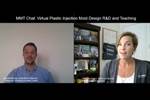This episode is brought to you by ISCAR with New Ideas for Machining Intelligently.
It was a constant struggle throughout Bruce Cateon’s entire career to find good engineers and train them, so this “Injection Mold Design Handbook” was his way of trying to address that need. He stressed that this was a community effort. It taught him that everyone in this industry wants to contribute, it just needed a person to bring it all together. Hence, Bruce’s passion project.
This handbook takes the reader from the plastic part right through to testing of a mold. The designers and engineering managers he spoke with wanted a handbook to help guide their new engineers on best practices. They didn't want a theory-heavy textbook, but something that could be used as handbook to which they could refer and learn.
Here are just a few tidbits from this conversation to whet your appetite for our full conversation:
- It's a great story of how Herbert Rees and I connected. He was a very passionate and innovative engineer. He created some of the first mold design manuals.
- The hardest part was the discipline to get up and write when sometimes you don't feel like it.
- Through the writing process, I realized that I know way less about mold design than I thought I did.
- I learned that the mold design knowledge in the industry is still fragmented, inconsistent and in some cases conflicting.
- Herbert Rees told me this at the very beginning, “The mold is the heart of the injection molding work cell. It is the single thing that change every time. Everything else in the work cell is a slave to that mold, and yet we give the mold much less important than it should have.”
- My favorite chapter is Chapter 18 with more than 40 different contributed mold designs!
- Some of the most critical chapters have less to do with mold design and more to do with the elements around mold design. For example, plastic part design and specifying the right molding machine for a mold.
- Beyond the continuing workforce challenge, two other big challenges for moldmakers today are thinking globally and investing in technology.
- 5 characteristics of the mold builder of the future: (1) resolute leadership, (2) global thinking (3) risk-taking (4) agility and (5) active listening.
For the full quick chat, watch above, and for more MMT Chats, click here.
This episode is brought to you by ISCAR with New Ideas for Machining Intelligently.
Related Content
-
Leading Mold Manufacturers Share Best Practices for Improving Efficiency
Precise Tooling Solutions, X-Cell Tool and Mold, M&M Tool and Mold, Ameritech Die & Mold, and Cavalier Tool & Manufacturing, sit down for a fast-paced Q&A focused on strategies for improving efficiencies across their operations.
-
Tackling a Mold Designer Shortage
Survey findings reveal a shortage of skilled mold designers and engineers in the moldmaking community, calling for intervention through educational programs and exploration of training alternatives while seeking input from those who have addressed the issue successfully.
-
How to Improve Your Current Efficiency Rate
An alternative approach to taking on more EDM-intensive work when technology and personnel investment is not an option.




